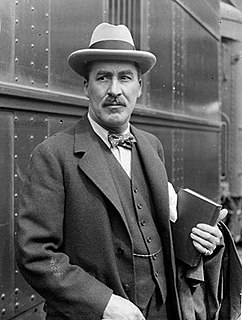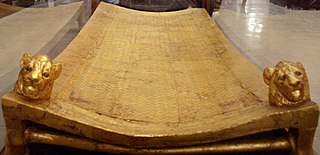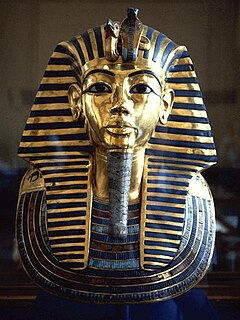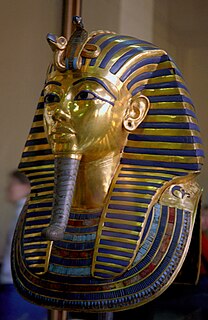Related Research Articles

Howard Carter was a British archaeologist and Egyptologist who discovered the intact tomb of the 18th Dynasty Pharaoh Tutankhamun in November 1922, the best-preserved pharaonic tomb ever found in the Valley of the Kings.

Tutankhamun, commonly referred to as King Tut, was an ancient Egyptian pharaoh who was the last of his royal family to rule during the end of the 18th Dynasty during the New Kingdom of Egyptian history. His father is believed to be the pharaoh Akhenaten, identified as the mummy found in the tomb KV55. His mother is his father's sister, identified through DNA testing as an unknown mummy referred to as "The Younger Lady" who was found in KV35.

Egyptology is the study of ancient Egyptian history, language, literature, religion, architecture and art from the 5th millennium BC until the end of its native religious practices in the 4th century AD. A practitioner of the discipline is an "Egyptologist". In Europe, particularly on the Continent, Egyptology is primarily regarded as being a philological discipline, while in North America it is often regarded as a branch of archaeology.

Zahi Abass Hawass is an Egyptian archaeologist, Egyptologist, and former Minister of State for Antiquities Affairs, serving twice. He has also worked at archaeological sites in the Nile Delta, the Western Desert, and the Upper Nile Valley.

The tomb of Tutankhamun, also known by its tomb number, KV62, is the burial place of Tutankhamun, a pharaoh of the Eighteenth Dynasty of ancient Egypt, in the Valley of the Kings. The tomb is smaller than other Egyptian royal tombs of its time, consisting of four chambers and an entrance corridor dug into the floor of the valley, and less extensively decorated. It probably originated as a tomb for a non-royal individual that was adapted for Tutankhamun's use after his premature death. Like other pharaohs, Tutankhamun was buried with a wide variety of funerary objects and personal possessions, such as coffins, furniture, clothing and jewellery, though in the unusually limited space these goods had to be densely packed. Robbers entered the tomb twice in the years immediately following the burial, but Tutankhamun's mummy and most of the burial goods remained intact. The tomb's low position allowed its entrance to be hidden by debris deposited by flooding and tomb construction, so unlike other tombs in the valley it was not stripped of its valuables during the Third Intermediate Period.
Joann Fletcher is an Egyptologist and an honorary visiting professor in the department of archaeology at the University of York. She has published a number of books and academic articles, including several on Cleopatra, and made numerous television and radio appearances. In 2003, she controversially claimed to have identified the mummy of Queen Nefertiti.

Joyce Ann Tyldesley is a British archaeologist and Egyptologist, academic, writer and broadcaster who specialises in the women of ancient Egypt.

Harry Burton was an English archaeological photographer, best known for his photographs of excavations in Egypt's Valley of the Kings. Today, he is sometimes referred to as an Egyptologist, since he worked for the Egyptian Expedition of the Metropolitan Museum of Art for around 25 years, from 1915 until his death. His most famous photographs are the estimated 3,400 or more images that he took documenting Howard Carter's excavation of Tutankhamun's tomb from 1922 to 1932.

Salima Ikram is a Pakistani professor of Egyptology at the American University in Cairo, a participant in many Egyptian archaeological projects, the author of several books on Egyptian archaeology, a contributor to various magazines and a guest on pertinent television programs.
Donald P. Ryan is an American archaeologist, Egyptologist, writer and a member of the Division of Humanities at Pacific Lutheran University in Tacoma, Washington. His areas of research interest include Egyptian archaeology, Polynesian archaeology, the history of archaeology, the history of exploration, ancient languages and scripts and experimental archaeology. He is best known for his research in Egypt including excavations in the Valley of the Kings where he investigated the long-neglected undecorated tombs in the royal cemetery. His work there resulted in the rediscovery of the lost and controversial tomb KV60, the re-opening of the long-buried KV21 with its two female and likely royal occupants, and tombs KV27, KV28, KV44, KV45 and KV48. In 2017, he rediscovered three small tombs in the Valley of the Kings which when first encountered in 1906 contained the mummies of animals including a dog and monkeys.
Josef William Wegner is an American Egyptologist, archaeologist and associate professor in Egyptology at the department of Near Eastern Languages and Civilizations of the University of Pennsylvania, where he obtained his Ph.D. degree in Egyptology. His father is the astrophysicist, Gary A. Wegner.

Exhibitions of artifacts from the tomb of Tutankhamun have been held at museums in several countries, notably the United Kingdom, Soviet Union, United States, Canada, Japan, and France etc.

Pierre Lacau was a French Egyptologist and philologist. He served as Egypt's director of antiquities from 1914 until 1936, and oversaw the 1922 discovery of the tomb of Tutankhamun in the Valley of the Kings by Howard Carter.

The curse of the pharaohs or the mummy's curse is a curse alleged to be cast upon anyone who disturbs the mummy of an ancient Egyptian, especially a pharaoh. This curse, which does not differentiate between thieves and archaeologists, is claimed to cause bad luck, illness, or death. Since the mid-20th century, many authors and documentaries have argued that the curse is 'real' in the sense of having scientifically explicable causes such as bacteria or radiation. However, the modern origins of Egyptian mummy curse tales, their development primarily in European cultures, the shift from magic to science to explain curses, and their changing uses—from condemning disturbance of the dead to entertaining horror film audiences—suggest that Egyptian curses are primarily a cultural, not scientific, phenomenon.
Percy Edward Newberry was a British Egyptologist.

The Eighteenth Dynasty of Egypt is classified as the first dynasty of the New Kingdom of Egypt, the era in which ancient Egypt achieved the peak of its power. The Eighteenth Dynasty spanned the period from 1550/1549 to 1292 BC. This dynasty is also known as the Thutmosid Dynasty for the four pharaohs named Thutmose.

Tutankhamun's trumpets are a pair of trumpets found in the burial chamber of the Eighteenth Dynasty Pharaoh Tutankhamun. The trumpets, one of sterling silver and one of bronze or copper, are considered to be the oldest operational trumpets in the world, and the only known surviving examples from ancient Egypt.
Colleen Darnell is an American Egyptologist. Her areas of expertise include Late Period uses of the Underworld Books, ancient Egyptian military history, the literature of New Kingdom Egypt, and Egyptian revival history.
Christina Riggs is a British-American historian, academic, and former museum curator. She specializes in the history of archaeology, history of photography, and ancient Egyptian art, and her recent work has concentrated on the history, politics, and contemporary legacy of the 1922 discovery of Tutankahmun's tomb. Since 2019, she has been Professor of the History of Visual Culture at Durham University. She is also a former Fellow of All Souls College, Oxford. The author of several academic books, Riggs also writes on ancient Egyptian themes for a wider audience. Her most recent books include Ancient Egyptian Magic: A Hands-On Guide and Treasured: How Tutankhamun Shaped a Century.
Aidan Mark Dodson is an English Egyptologist and historian. He has been Honorary Professor of Egyptology at the University of Bristol since 1 August 2018.